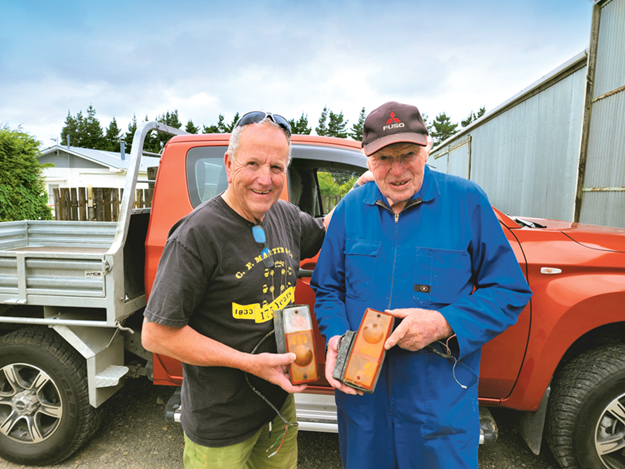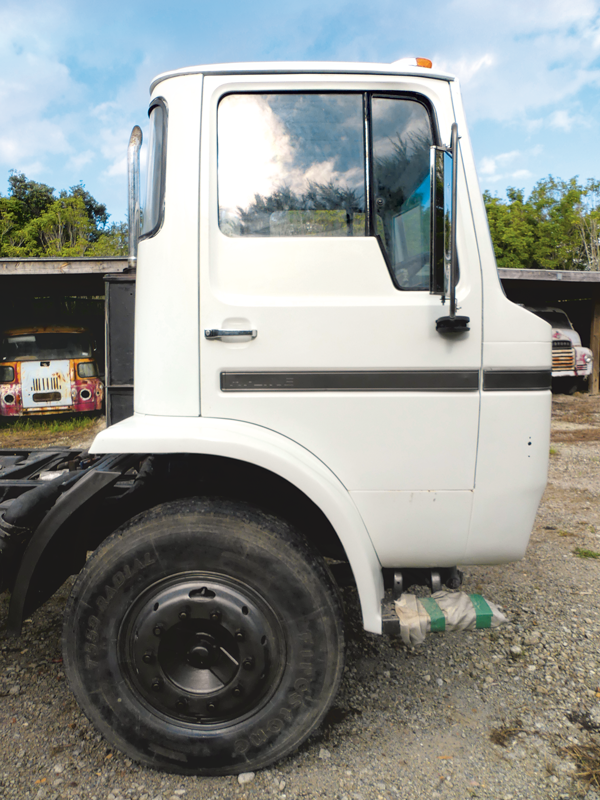Restoration: Dodge RG13 — Part 22
It’s funny how the older we get, time seems to pass us by more and more rapidly, a fact I was reminded of by a much younger mate of mine only a couple of years ago.
 |
|
Lyndsay and Noel with a sought-after commodity — two indicator units
|
My friend, who was about 40 at the time of making his observation, was walking around my collection of old Bedfords, along with the Dodge I’m currently working on when he suddenly blurted out a comment that I momentarily took as a bit of an affront.
"Whittle, you’re never going to get all of these trucks completed," he said. My immediate thought was to give him a piece of my mind, but fortunately, my workshop buddy Murray saved the situation by quoting an old saying, which goes something along the lines of ‘when a man finishes his house, it’s time to die’.
It took me a few moments to get my head around the comments being thrown at me from all directions, but it finally dawned on me that one day, not too far off, the time would come when I’d either run out of steam or die in the middle of a restoration.
All three of us stood there in silence for what seemed like an eternity, and then we all let out a huge laugh. At the time of that strange event, I figured that I probably had eight to
10 years of restorations left in me, just about enough time to do a ‘quick flick’ on the Dodge and a full restoration on either the A3 or the A5 Bedford (depending on which one would be easiest to do) and finish off my tenure with the big S Bedford.
Given that it generally takes between two-and-a-half to three years to complete a restoration, I felt that this ambition would be reasonable to achieve.
A slow learner
Lately, I’ve been harbouring a growing concern surrounding the fact that every time I complete a restoration, I’m making a rod for my own back by adding the extra expense of keeping yet another vehicle up to a Certificate of Fitness (COF) standard.
It was one of those things that I’ve often thought I’d deal with as time went by, however, a couple of weeks ago, it felt like I’d been hit on the head with a sledgehammer during a trip to the VTNZ testing station with my first restoration — the trusty old 1953 K Bedford.
It wasn’t all that long ago that it was costing around $140 for a COF check, something I felt happy with even though my one is the only K Bedford in the country on a COF — the other three that I know of are all on WOFs.
Last month, the bill I was lumbered with came in at a whopping $260, which included the extra $20 fee VTNZ is charging for trucks that are more than 20 years old.
The whole point of the rant so far is that I can’t carry on restoring things that will probably wind up running me broke simply for the pleasure of driving around for a hundred kilometres (mostly less) between $260 spends at the testing station.
As if the almost 100% increase in the cost of a COF check in the last couple of years isn’t enough of an insult, I’m told that had the old K failed its check, I would’ve landed with yet another bill for the recheck; fortunately, I’d done my homework and it passed.
It’s with this in mind that I’m going to have to call time on this restoration lark once this current project is completed. Still, all good things must come to an end at some point in time. At least that’s what they say.
Where we’re currently at
 |
|
Inside the cab is coming along too
|
By a reasonable reckoning, we should be nearing the end of the RG13’s restoration by around August/September this year, meaning that somebody’s going to have to get their act together in pretty short order.
The wiring loom is now nearing completion and is connected to the start key, the windscreen wipers now operate on both speeds and park correctly. We’ve also managed to get the orange marker lights lit up on the top of the cab.
Just the headlights and park lights/indicators to fit and get working and the lighting side of things will be completed. Once we’ve cleared the cab end of the truck, we’ll be able to light up the taillights, as we already have the junction box fitted, ready to connect all the lights at the rear end, however, there’s a bit of work to get through before this happens.
 |
|
The passenger seat will have to come out to fit the better mats recently obtained by Noel
|
I’ve been able to fit the passenger’s seat, although, this might have to come out again, as there’s the possibility my old mate Noel Galloway has come across a set of floor mats that might be in better condition than the ones currently fitted.
 |
|
Decorative strips on both sides — another step to completion
|
Also, the decorative body strip has finally made its way onto the cab along with another one of Mr Galloway’s finds — the much-coveted Dodge Badge.
Parts foragers
.png) |
|
Lyndsay and Noel with a sought-after commodity — two indicator units
|
Noel has played a pivotal role in this restoration, as he’s constantly on the lookout for derelict RG Series in either Commer or Dodge configurations.
So far, he’s come up with a Dodge cab, which provided the floor mats I recently fitted, along with the Dodge badge and centre mouldings, plus a truckload of other useful bits that have allowed me to configure the truck as a Dodge, rather than a Commer.
‘Mr Parts Finder’, as I’ve come to dub Noel, has just come back from an excursion to Palmerston North to forage some more useful bits and pieces that include the above-mentioned floor mats and perhaps even more importantly, a pair of front indicator units.
Having found his second donor vehicle for this project, Noel took his mate John Blair and drove a 45-minute trip from Woodville into Palmy to harvest as many parts as they could grab in a morning. Thank you gents; your efforts are greatly appreciated.
All I need to do now is to get down to Woodville to collect the harvest and bring it back to Auckland. It’s strange how when writing these articles, I start remembering all the little (and not-so-little) things that I need to put on the ‘to-do’ list, one of them being that
I still must get the accelerator mechanism up and running.
I know this sounds simple enough; the trouble is that once again, I didn’t take any photos before it all came apart. After all, I did say I was a slow learner.
Find new and used heavy machinery for sale in NZ
Keep up to date in the industry by signing up to Deals on Wheels' free newsletter or liking us on Facebook.





.jpg)


.jpg)


.png)
.png)
.png)
.png)
.png)
.jpg)
